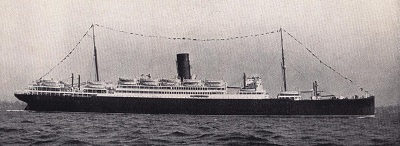Cunard: The First Continuous World Cruise
When Cunard Line’s Britannia left Liverpool on July 4, 1840 it changed the face of ocean travel forever as that ship inaugurated the first-ever scheduled service across the Atlantic.
Over 80 years after its founding Cunard Line inaugurated another first when in November 1922 the American Express Company initiated the first ever continuous circumnavigation of the globe by passenger liner when they exclusively chartered Cunard's Laconia for the purpose. The cruise was to visit waters first explored by Magellan's fleet four hundred years previously, during the first circumnavigation of the globe.
The world cruise has since become the ultimate travel experience and remains the dream of many people today. Since that November 1922 departure no other company has undertaken more world cruises than Cunard or carried more passengers on world cruises.
 Prior to the First World War there had been instances when ships were diverted from their regular ocean crossings to cater for a new type of passenger. These travellers went to sea for the pleasures offered by a leisurely voyage in good company; in other words, a cruise. Americans wishing to see the cultural gems of Europe, and British travellers with the time and where-with-all to tour the famous sites of Egyptian, Greek and Roman antiquity, were made welcome. Others had previously billed so-called round-the-world cruises, but in these cases more than one ship had been used and passengers had crossed the United States by rail.
Prior to the First World War there had been instances when ships were diverted from their regular ocean crossings to cater for a new type of passenger. These travellers went to sea for the pleasures offered by a leisurely voyage in good company; in other words, a cruise. Americans wishing to see the cultural gems of Europe, and British travellers with the time and where-with-all to tour the famous sites of Egyptian, Greek and Roman antiquity, were made welcome. Others had previously billed so-called round-the-world cruises, but in these cases more than one ship had been used and passengers had crossed the United States by rail.
Laconia had entered service in May 1922 and was designed for the Southampton to New York Atlantic run. Its profile was typical of the new generation of post-war Cunard ships with its single funnel, a length of just over 600-feet and gross tonnage of 20,000. Although small by today’s standards Laconia and its sister ships were built to accommodate 2,200 passengers - slightly more than today's 90,000-ton Queen Victoria and Queen Elizabeth and not much less than the 150,000-ton Queen Mary 2.
Most of those passengers would travel in a crowded Third Class while crossing the Atlantic but for world cruising Third Class would be closed. American Express advertising claimed “membership in the cruise would be restricted to 450.” The words membership and restricted set the tone and the general impression that Laconia would be filled with 450 millionaires for the trip was given when in fact the majority of passengers perfectly ordinary middle class Americans. World Cruise capacity was restricted to just above the number of First Class passengers carried on the Atlantic (347) which suggested no crowding and that only the best cabins would be used.
Laconia would be one of four ships to circumnavigate the globe that winter but the other three (Cunard’s Samaria, the French Resolute and Canadian Pacific’s Empress of France) would not leave New York until January 1923.
Laconia’s 130-day voyage departed on 21 November 1922 and would arrive back in New York on 30 March 1923 after calling at 22 ports. The first continuous circumnavigation by a passenger liner headed westward through the Caribbean, the Panama Canal (it would be the first liner of its size to transit this canal), across the Pacific and back to the United States via the far East, the Suez Canal, the Mediterranean and the Atlantic. It did not visit Australia and New Zealand.
As Laconia was the first it was accorded the warmest welcome of the four ships and since no ship like it had called at many of the ports since before the war it was greeted with enthusiastic delight. Laconia would pass its sister, Samaria, in the Indian Ocean – future meetings of Cunard ships during world cruises would become the norm.
To commemorate the completion of such an historic voyage the ‘Laconia Cup’ was presented to Captain F G Brown RNR by American Express. Today this important item resides on Queen Victoria in her Cunardia Exhibition.

that matters most
Get the latest maritime news delivered to your inbox daily.
Franconia would assume the World Cruise mantle and undertake several before 1939 while Laconia would revert to its Atlantic shuttle sailing from Liverpool to Cobh to Boston to New York. Laconia would also make occasional voyages from Hamburg, and in the 1930s was engaged to a large extent on cruise service. In January 1938 the vessel left Liverpool on a 52-day cruise covering 14,108 miles.
Laconia was sunk in 12 September 1942 after being hit by two torpedoes.
